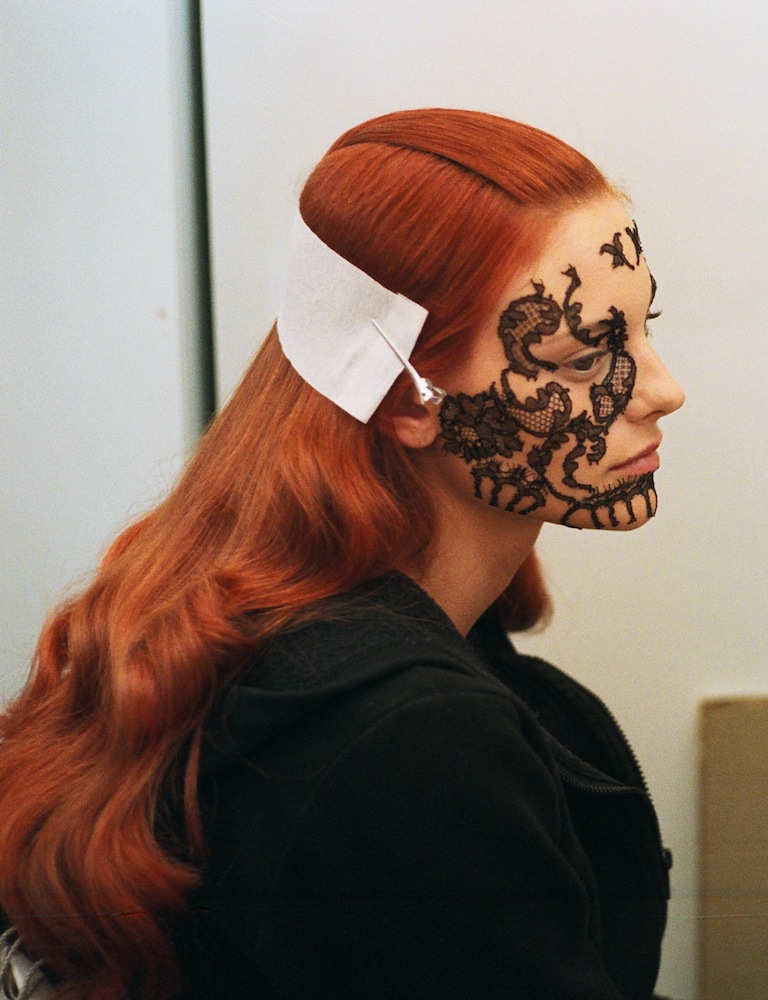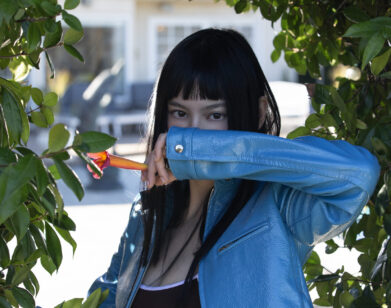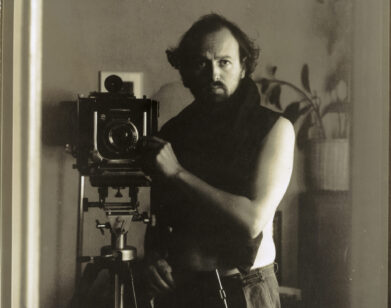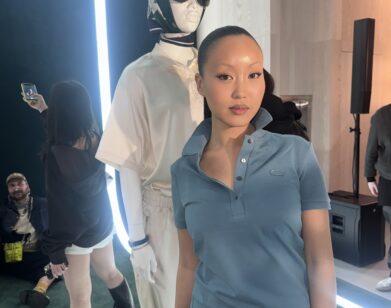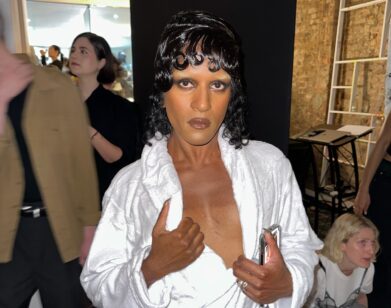The Look: Riccardo Tisci
Since taking the helm of Givenchy in 2005, Italian-born designer Riccardo Tisci has brought a distinct vision of beauty and unity to the iconic French maison. He has assembled a team of collaborators (including Mariacarla Boscono, Marina Abramovic, makeup artist Pat McGrath, hairstylist Luigi Murenu, and Kanye West) that he considers nothing less than family. With next year marking a decade of Tisci’s iconoclastic reign as creative director of the brand, we look back at the masterful way he has used beauty to represent the Givenchy tribe. Tisci’s Spring/Summer collection found inspiration in the intersection of Japanese and African tradition, topped off with exquisitely constructed crystal face masks engineered by McGrath. Employing 1,500 crystals per face, beading, sequins, glitter, and two types of paint overlaid with a piece of sheer black netting, the futuristic, abstract tribal masks took three hours to apply.
HARRY BRANT: What I really love about the tribal makeup in the spring show is that it gives a sense of unity.
RICCARDO TISCI: You know, I come from a family with eight sisters. I’m the last one. I really believe in families, gangs, tribes. Some people have other things that make a uniform. For me, creating the clothes of Givenchy is the way to make my tribe. It’s related to religion, too, because it’s people trying to find identity—the young generation is looking for tribes. You have the hip-hop tribes, the punk tribes, the rockers, you have the hipsters, the bourgeois … The fact of the tribe is that it’s like a religion. Punk is like a religion, because it’s a belief.
BRANT: You’re right—it’s like one big team.
TISCI: It’s like a family. I think the decoration that you put on the face—sometimes it can be makeup, sometimes it can be jewelry—is the stuff that has always attracted me. I found it very special and personal. I used to be a goth, when I was, like, 14. I used to have a lot of piercings and long black hair. I used to be obsessed with the Cure. I had a problem communicating with people. My friends were my older sisters. They were my gang. I used to find people my age boring.
BRANT: That’s exactly how I feel.
TISCI: I’m from a Catholic, Italian family. My mom didn’t want me to be out with older people. So I was a little nerd. I would stay at home, listen to a lot of goth music, and I was wearing full-on makeup, with dyed-green hair. I was wearing only black, skirts on top of trousers. These things that are “my style,” and the fact that I’m doing tribes, are what I dreamed to find when I was in my youth. I couldn’t find it in Italy. Italians are very conservative. I would walk down the street, people would think I was crazy, and they would scream things at me. When I was 17, I decided to leave, because I needed to find my tribe.
BRANT: What inspired you to start doing nose rings?
TISCI: It was from my goth phase. I’ve always been obsessed with African culture, or any culture—Brazilian, African, Nigerian—that, for religion or for beauty, decorates themselves. I’ve always been attracted to Moroccan ladies wearing this amazing veil on top of the jaw. I’m attracted to ornamentation. I’m obsessed with the streets. I’ve been lucky to do couture, to be up there in the luxury world, and to be able to do street and urban fashion. I’m very attracted to the metallic stuff—all the diamond Victorian ornamentation, or Moroccan, Nigerian, and aboriginal from Australia and Brazil.
BRANT: I think it mixes together in a really interesting way, to broadcast it to an audience who would never even consider dressing up their face. How did you guys come up with this mask?
TISCI: It was Pat [McGrath] and [hairstylist] Luigi [Murenu]. The way I work with Pat and Luigi is very interesting. I’m one of the only designers that they call two weeks before the show. The moment they arrive in Europe, even before they arrive in Paris, Pat calls me and says, “What is it going to be this season?” I’m obsessed with beauty, with decoration as a statement in history. That season, the inspiration was a car crash between Japanese and African.
BRANT: I can see the Kabuki influence.
TISCI: It was Serge Lutens. I had pictures that I really loved by Lutens called Caviar—pictures of this lady with what looks like caviar on the face. Then I had a lot of African masks. I said, “Pat, I have a really heavy job for you.” She couldn’t believe it in the beginning. I said, “No, baby, I really want to do it.” When I say something, I go to the end. She was amazing—she spent hours and hours and days and days in my office with me. She mixed all these beautiful colors to make this mask, like a couture Van Gogh.
BRANT: It’s almost like a second skin. Do you think that using face jewelry or anything like that will ever become popular in beauty for everyday?
TISCI: When I was a kid, I was looking at Blade Runner [1982]. I always thought that 2015 would be like Blade Runner. I wish. I’m still like a kid in my head—I wish in 20 years people will do full jewelry on the face.
BRANT: Even with Kanye West wearing the big mask with the Givenchy stars on it—it spreads. I think that it’s amazing that you can have the high-couture level, and have the beautiful ornamental earrings and nose rings, and also have the mask that will be seen by tons of rap fans, and then will affect rap culture. Actually, there are kids at my school who come in wearing a fake version of the Givenchy T-shirts, the ones that are really long with all the beautiful flowers, because they saw Kanye West wearing the real version.
TISCI: The guy’s a rock star. Kanye’s a very intelligent guy. I’m a Leo, you know. We’re very open-minded. We don’t have boundaries. He asked me to design the cover [for the album Watch the Throne], and I worked with him and Jay-Z, which was amazing and new for me, because they didn’t take me as a designer, they took me as an art director. I remember when we talked about clothes, they said, “What do you think we should wear?” I said, “I think you guys should wear a kilt. I think it’s quite beautiful to introduce a leather kilt, a masculine kilt, because it’s not related to a woman’s wardrobe; it’s related to the strength you have in your masculinity.” Kanye said, “Okay, if you think I will look good, we should try.” It became such an iconic thing.

